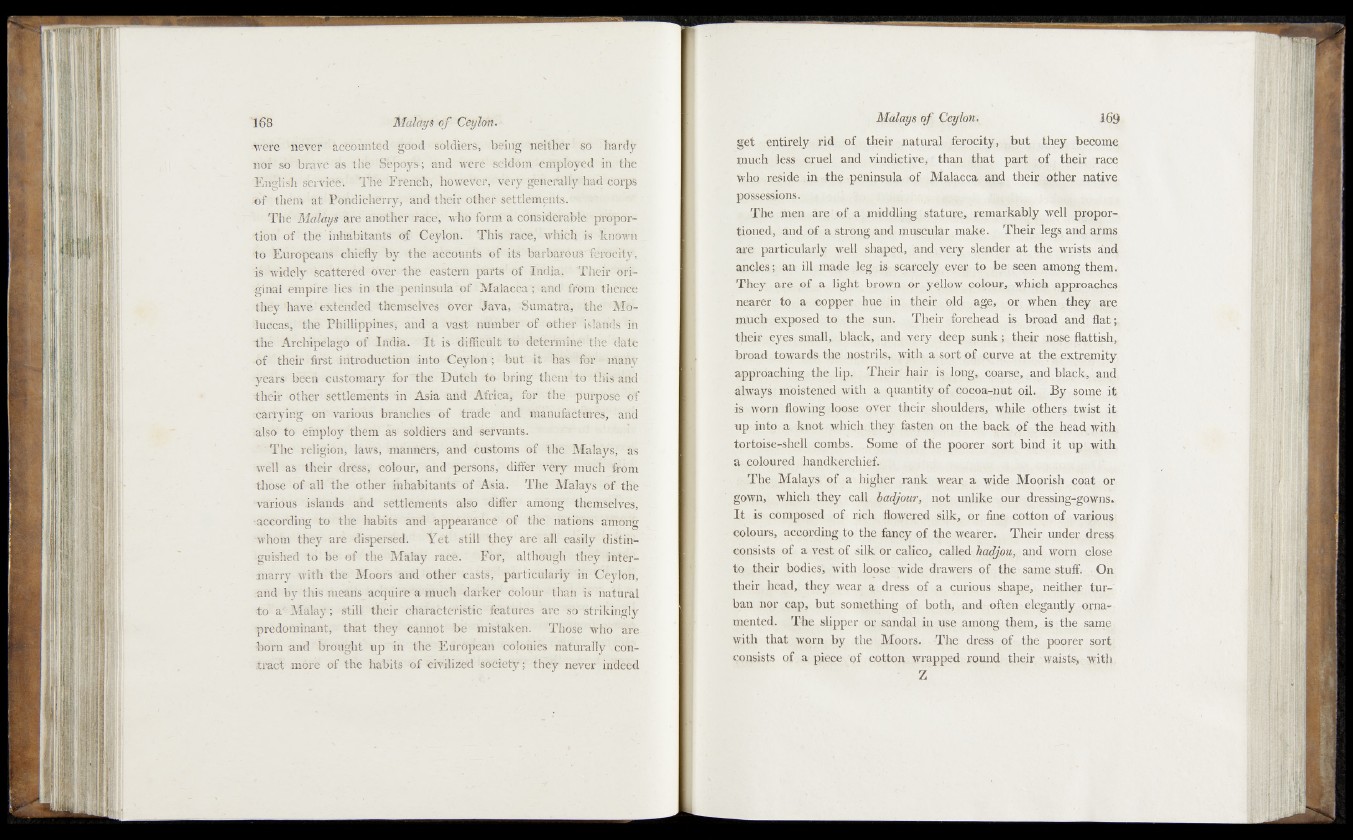
were never ' accounted1 good Pifidieis,- being neither so ■ hardy
rro’r so brave' as tlife Sèpoÿs-; and were Sfcldèntd employed in the
English service. Thé French, howeveik very generally had corps
;ef them at Pondicherry, and their other settlements.
The Malays are another race, who form a considerable proportion
of the inhabitants of Ceylon. This race, which is known
to Europeans chiefly by the accounts of its barbarous'ferocity,
is widely scattered over, th e eastern parts' of India. Their Original
empire lies in the peninsula p f Malacca ; and from thence
they have ‘ extended, themselves, oyer Java, '.Sum'atra, the Mo-
liiccas, the Phillippinesj and à vast number Of other islands in
the Archipelago of India. I t is - difficult to determine the date
of theirÎfirst introduction into Céÿl&n ; but it has ' f e -m a n y
years beeii customary for "the Dutch to bring them do this arid
■their other settlements in Asia and Africa, for thé; purpose of
^carrying- on' various branches of trade a n d . manufactures, ' and
ialso to employ them .as soldiers and 'servants < "
' The • religion, laws, manners, and customs of the Malays, as
veil as their dress,- colour, and persons, differ very much horn
those of all th é other inhabitants of Asia. The Malays of the
various islands and settlements also differ among themselves,
-according to the habits and appearance of the nations among
whom they are dispersed. Yet still they are all easily distinguished
to be of the Malay race. For, althought -they ;intermarry
-with the Moors and other casta, particularly iirCeylon,
and by this means acquire a much darker colour than is natural
do a" Malay ; still their characteristic features are so strikingly
predotainant, that they cannot bé - mistaken. Those who 'ai-e.
bom and brought up in the European colonies naturally .contract’
more of the habits of civilized Society ; they never indeed
get entirely . rid ^ o f, their natural ferocity, .b u t they become
^nueh less j^uel anJi. ylndictiyejjthan fth at part mf their/race
Who reside ,in ^fhe .peninsula .Malacca; and their ^yther native
possessions. &
| Thu men argLof.a middliuc statutg,,: remarkably well proportioned,
and of a strong and>muscular make. Their.jegs, and arms
are particnlarlji well shaped,, ,andtvery slepdeyat ,the wiists and
ajsciessa.an ill made Jpg fs^pMcefeeyMciP/J^eiseep .among-tpem.!
They arp pf a light brown dr yellow colonr.^whiqk .approaches
nearer to a^eopper hue^in'. theim gjld( •„ age, or when,,, they are
much,exposed.!®, the, sun. Their^S p ehead is, broad ,and flab
their jjgyps^smalh Alack, and^e^y deep ^mnk^ thpir jUgse flattish,:
broad towards* the np&irils, wijbh^s^r-t of rpuryp at- extremity
approaching the lip . .Their, lyh.r: is^ipng8 <marse, :%nd.bl^ck,,.,and,
alwaysi moistened, with a ,^ a p tit-y u f4coGp%mptmi]. Byf gpme, it;
is .worn flo\y4ng;/lgosemy^^l^eiF^s;hspaiders,^ while atjiecs twist it
up into .a knot whiqh^they fasten, on the bgek. ofkthg head jybdjh
tortoiser.sh.ell combs. Sgme pf the poorer SMtibffld.it up'with,
coloured handkerchief.^^:
The Malay^M .a higher .rank .weai;,a wide :Yfopm}y<cpat , or
gown, which they call., badjour, pot unlike -ourndressing-gow-ns-
I t is composed of rieh flowered silk, or,,fine-, cotton .of,.variousj
Uolpurs, according.to’the.fancy of t]Je wearer Their undeuidresk
in s is ts ofi a V,est,pf silk. pr. calico, calledhadjou, and vyorjl c|©§e
to their bodieski|vith lpose.wide dfaw^r§, of the ■ saprp ,stp fh rOn
their head,.d^ey^^eanm,dress of a curious.shape,inef|f^er-,turban
n o rc ap , but something q£ botiju and.yo£ten:elegantJy qjrnar
mented, The slipper pi* sandal in .use among l^em, .is the gapifn
With that worn by the Moors,. -The drevs.s .of%th& poorer
consists of a; piece p f cotton, wrapped round their waists> with
H